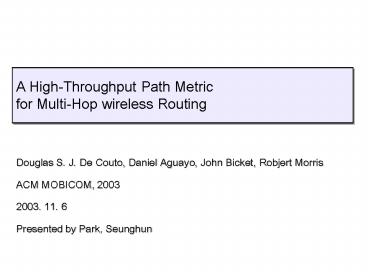CMMI Appraisal Methods - PowerPoint PPT Presentation
1 / 13
Title:
CMMI Appraisal Methods
Description:
If the highest throughput path has three or fewer hops, ETX is likely to choose it ... Reduction of throughput due to interference among the successive hops of a route ... – PowerPoint PPT presentation
Number of Views:32
Avg rating:3.0/5.0
Title: CMMI Appraisal Methods
1
A High-Throughput Path Metric for Multi-Hop
wireless Routing
Douglas S. J. De Couto, Daniel Aguayo, John
Bicket, Robjert Morris ACM MOBICOM, 2003 2003.
11. 6 Presented by Park, Seunghun
2
Contents
- Introduction
- Performance of Minimum-Hop-Count Routing
- ETX Metric Design
- Implementation
- Evaluation
- Conclusion
3
Introduction
- Metric commonly used by existing ad hoc routing
protocols is minimum hop-count - In a dense network there may be many routes of
the same minimum length, with widely varying
qualities - Arbitrary choice is not likely to select the best
- Proposed solution is ETX (Expected transmission
count) metric - Primary goal is to find paths with high
throughput, despite losses - Evaluation
- Demonstrate measurements taken from test-bed
network
4
Performance of Minimum Hop Count Routing
- Data throughputs
- Distribution of path throughputs
Best static route
DSDV hop count
5
ETX Metric Design (1/2)
- Metric
- ETX of a link is the predicted number of data
transmissions required to send a packet over that
link, including retransmission - ETX of a route is the sum of the ETX for each
link in the route - ETX of a link is calculated using the forward and
reverse delivery ratios of the link - Expected number of transmission
- ETX
1
df?dr
6
ETX Metric Design (2/2)
- Characteristics
- Based on delivery ratios, which directly affect
throughput - Detects and appropriately handles asymmetry by
incorporating loss ratios in each direction - Use precise link loss ratio measurements to make
fine-grained decisions between routes - Penalizes routes with more hops, which have lower
throughput due to interference between different
hops of the same path - Choose the best path
- If the highest throughput path has three or fewer
hops, ETX is likely to choose it - If the best path has four or more hops, ETX may
choose a slower path that has fewer hops
7
Implementation (1/2)
- Background
- DSDV
- Every node has a routing table entry which
contains four fields IP address, the next hop,
the latest sequence number, the metric - Every node broadcasts a route advertisement
packet (full dump) containing its complete
routing table - Each route entry has an associated WST (Weighted
Settling Time) - WST is used together with triggered updates
- Triggered updates are not sent until at least
2?WST has passed since first hearing the current
sequence number - DSR
- Node issues a route request when it has data to
send - Each node appending its own address to each
request it receives, and then re-broadcasting - Destination issues a route reply in response to
every forwarded request it receives
8
Implementation (2/2)
- Changes to DSDV
- Dose not advertise a route until 2?WST has passed
since that particular route was heard - Does not use link-level feedback to detect broken
links and produce broken-route messages - Full dumps are never sent on a triggered update
- Route is not used until it is allowed to be
advertised - Changes to DSR
- Node forwards a request, it appends not only its
own address, but also the metric for the link
over which it received the request - When a node receives a request, it forwards it
again if the accumulated route metric is better
than the best which it has already forwarded with
this request ID
9
Evaluation (1/5)
- Metric performance with DSDV
DSDV hop count
Best static route
DSDV ETX
10
Evaluation (2/4)
- Metric performance with DSDV (contd)
DSDV hop count
DSDV ETX
11
Evaluation (3/4)
- Metric performance with DSR
DSR hop count
DSR hop count
Best static route
Best static route
DSR ETX
DSR ETX
12
Evaluation (4/4)
- Accuracy of link measurements
13
Conclusion
- Route selecting using ETX accounts for
- Link loss ratios
- Reduction of throughput due to interference among
the successive hops of a route - Contributions
- Explains why minimum hop count often finds routes
with significantly less throughput than the best
available - Presents the design, implementation, and
evaluation of the ETX metric - Describes detailed design changes to the DSDV and
DSR protocols, that enable them to more
accurately choose routes with the best metric































